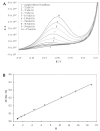Copper Complexing Capacity and Trace Metal Content in Common and Balsamic Vinegars: Impact of Organic Matter
- PMID: 32075327
- PMCID: PMC7070403
- DOI: 10.3390/molecules25040861
Copper Complexing Capacity and Trace Metal Content in Common and Balsamic Vinegars: Impact of Organic Matter
Abstract
Complex formation is among the mechanisms affecting metal bioaccessibility. Hence, the quantification of organic metal complexation in food items is of interest. Organic ligands in solutions of environmental and/or food origin function as buffering agents against small changes in dissolved metal concentrations, being able to maintain free metal ion concentrations below the toxicity threshold. Organic matter in vinegars consists of bioactive compounds, such as polyphenols, Maillard reaction endproducts, etc., capable of complexing metal ions. Furthermore, transition metal ions are considered as micronutrients essential for living organisms exerting a crucial role in metabolic processes. In this study, differential pulse anodic stripping voltammetry (DPASV), a sensitive electrochemical technique considered to be a powerful tool for the study of metal speciation, was applied for the first time in vinegar samples. The concentrations of Cu complexing ligands (LT) in 43 vinegars retailed in Greece varied between 0.05 and 52 μM, with the highest median concentration determined in balsamic vinegars (14 μM), compared to that of common vinegars (0.86 μM). In 21% of the vinegar samples examined, LT values were exceeded by the corresponding total Cu concentrations, indicating the presence of free Cu ion and/or bound within labile inorganic/organic complexes. Red grape balsamic vinegars exhibited the highest density of Cu ligands per mass unit of organic matter compared to other foodstuffs such as herbal infusions, coffee brews, and beers. Among the 16 metals determined in vinegars, Pb is of particular importance from a toxicological point of view, whereas further investigation is required regarding potential Rb biomagnification.
Keywords: copper complexation; organic ligands; trace metals; vinegars.
Conflict of interest statement
The authors declare no conflicts of interest.
Figures





Similar articles
-
Copper complexing properties and physico-chemical characterisation of the organic matter in Greek herbal infusions.Food Chem. 2014 Oct 1;160:53-60. doi: 10.1016/j.foodchem.2014.03.080. Epub 2014 Mar 24. Food Chem. 2014. PMID: 24799208
-
The physicochemical properties and antioxidant capacities of commercial and homemade Greek vinegars.Acta Sci Pol Technol Aliment. 2019 Jul-Sep;18(3):225-234. doi: 10.17306/J.AFS.0669. Acta Sci Pol Technol Aliment. 2019. PMID: 31569905
-
Characterization of balsamic vinegar by multivariate statistical analysis of trace element content.J AOAC Int. 1998 Sep-Oct;81(5):1087-95. J AOAC Int. 1998. PMID: 9772749
-
Varieties, production, composition and health benefits of vinegars: A review.Food Chem. 2017 Apr 15;221:1621-1630. doi: 10.1016/j.foodchem.2016.10.128. Epub 2016 Oct 31. Food Chem. 2017. PMID: 27979138 Review.
-
Pesticidal copper (I) oxide: environmental fate and aquatic toxicity.Rev Environ Contam Toxicol. 2011;213:1-26. doi: 10.1007/978-1-4419-9860-6_1. Rev Environ Contam Toxicol. 2011. PMID: 21541846 Review.
References
-
- Plessi M. Vinegar. In: Caballero B., Trugo L.C., Finglas P.M., editors. Encyclopedia of Food Sciences and Nutrition. 2nd ed. Volume 9. Academic Press; Oxford, UK: 2003. pp. 5996–6004.
-
- Paneque P., Morales M.L., Burgos P., Ponce L., Callejon R.M. Elemental characterization of Andalusian wine vinegars with protected designation of origin by ICP-OES and chemometric approach. Food Control. 2017;75:203–210. doi: 10.1016/j.foodcont.2016.12.006. - DOI
-
- Giudici P., Gullo M., Solieri L. Traditional balsamic vinegar. In: Solieri L., Giudici P., editors. Vinegars of the World. Volume 10. Springer; Milan, Italy: 2009. pp. 157–177.
MeSH terms
Substances
LinkOut - more resources
Full Text Sources

